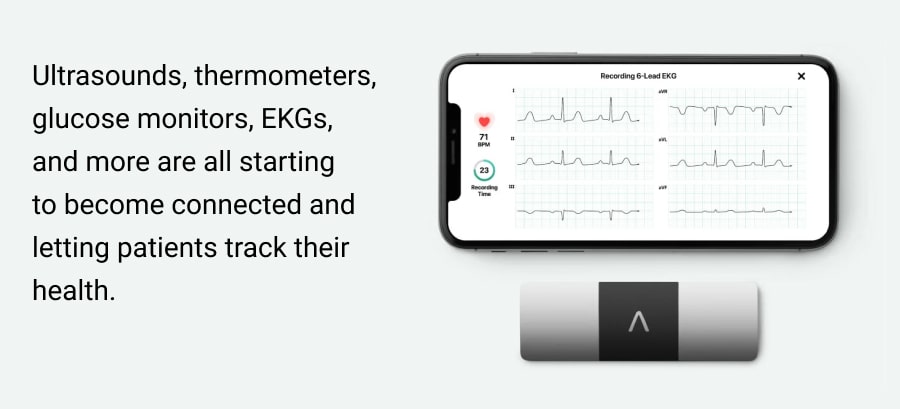Before the Internet of Things appeared on the horizon of healthcare, the delivery of medical services was limited to visits and telecommunications. Obviously, the Internet of Healthcare Things (IoHT) has redefined the landscape of the industry.
MarketsandMarkets Research revealed that the size of the global medical IoT market is expected to grow from $127.7 billion in 2023 to $289.2 billion by 2028. To understand why this term gets so tossed around and what it means for the healthcare sector, let’s explore in more detail what IoT in healthcare is, its examples, advantages, and considerations.
What Is the Internet of Healthcare Things
In simple words, the Internet of Healthcare Things, also known as the Internet of Medical Things, is the ecosystem of connected medical devices and technology solutions designed to serve the health and social care industries.
It includes a dizzying number of apps and sensors that collect and transmit data continuously so it can be further analyzed. Smart thermometers, glucose meters, connected inhalers, and blood pressure meters are good examples of IoT applications in the healthcare industry. They are frequently used for collecting, monitoring, and analyzing valuable health data.
It’s hard to underrate the importance of IoT solutions in healthcare, since, in general, they aim to improve access to medical data, elevate the quality and efficiency of treatment, and enhance the patient experience.
How Is IoT Used in Healthcare

Let’s take a look at the use cases of healthcare IoT across various target audiences. Below, there are four categories that we want to highlight as they benefit from the technology the most.
For patients, medical IoT provides vast opportunities to monitor health conditions and prevent various diseases. For example, glucometers and automated insulin delivery (AID) systems offer patients treatment on the spot. That’s particularly valuable for the older generation.
For health professionals, connected devices help deliver more personalized services and immediate medical care to patients. Monitoring the state of health in an ongoing manner, IoT allows doctors to make diagnoses more precisely and control treatment adherence.
For hospitals, the Internet of Things carries numerous options for usage in many areas. It helps track medical equipment on-premises, monitor hygiene to ensure a sterile environment, or control drug inventory.
For health insurers, data received with IoHT can enhance underwriting and claim management processes. Additionally, insurance companies can have more details about their customer behavior and tailor services based on the generated data.
What Impact Will the IoT Have on the Medical Sector?
In general, the abundance of patient data collected by IoT devices will continue to grow exponentially. However, this data is useless until it transforms hypotheses into actions. With IoHT helping build intelligent infrastructure, the medical environment has more opportunities to make the right moves.
You can learn more about the future of IoT in healthcare and its impact from the video below.
Benefits of IoT Application in Healthcare
Enhanced Quality of Treatment
IoHT sensors collect valuable data that allows for making informed decisions and offering patients evidence-based treatment. The use of connected devices for medical services ensures accurate data results and eliminates the risk of errors related to the human factor.
Moreover, IoT medical apps help improve drug and therapy adherence management, allowing doctors to track compliance with prescriptions and guarantee coordinated care delivery. Eventually, it enhances the quality of services.
Improved Patient Experience
A variety of IoHT technologies paired with telemedicine approaches increase patient engagement and provide them with more personalized and efficient service. Remote patient monitoring, smart hospitals, and home care solutions enhance access to healthcare services which is particularly vital for the elderly.
Learn how a Post-Acute Care Coordination System Helps Track Outpatients at Home
The application of smart devices in healthcare accelerates data processing, which reduces the time for diagnosis and decision-making. Ultimately, it drives better patient outcomes and boosts the overall patient experience.
Reduced Costs
Adopting IoT solutions for RPM, assisted living, or chronic care management, healthcare providers can consult and monitor patients in real time. It drastically decreases the number of offline visits, hospital stays, and readmissions. All this leads to the reduction of the overall cost of services.
Elevated Efficiency
While IoT provides a multitude of opportunities to collect a trove of valuable data, it also allows medical specialists to analyze electronic health records and get meaningful insights. Empowering clinical trials and studies, IoHT propels progress in the healthcare industry.
Learn more about the Role of Data Analytics in Healthcare
On top of that, IoT, AI, and ML technologies working together can automate workflows, assist with disease prediction, and suggest treatment options. Thereby, the Internet of Medical Things advances the efficiency of the delivered care.
Challenges of IoT in Healthcare
Security and Privacy
Alongside many advantages that IoT devices and software offer to the healthcare sector, it also brings some vulnerable security spots. Connected devices generate, process, and transfer a colossal amount of protected health information (PHI).
The HIPAA Journal shared the Healthcare Data Breach Report that revealed a 23% increase in the number of records breached in February 2024 compared to the previous year.
It means that healthcare providers leveraging IoT solutions should focus on their security policies, while developers should grapple with possible gaps to protect sensitive data from fraud and theft.
Explore more on the Security Issues and Challenges in IoT
Legacy technology is another issue that requires close attention. Often, hospitals use medical equipment and machines that are reaching the end of their lifecycle. Therefore, they can miss important security updates and lack the support of manufacturers, which increases the risk of breaches.
Regulations
When implementing the Internet of Things, one of the biggest challenges is the compliance of solutions with industry standards and regulations. Healthcare software and hardware must adhere to a number of rules; otherwise, you risk encountering significant penalties for violations.
There is a wide range of requirements that regulate the development and usage of IoMT devices and apps. Main guidelines like FDA and HIPAA and healthcare messaging standards like HL7, FHIR, CDA, and DICOM will help you protect PHI.
Read more about HIPAA Compliant App Development
Connectivity
For seamless, efficient, and uninterrupted therapy, healthcare professionals and patients should be confident in the absolute connectivity between IoT applications, systems, and devices. It’s essential then to eliminate latency in a medical environment and ensure interoperability among smart solutions.
To achieve this, your IoT development partner should focus on building an agile, scalable, and secure network infrastructure that will enforce policy rules and support interactions between all components of the IoHT system.
Examples of IoT Devices in Healthcare

Source: Business Insider Intelligence
The market offers a myriad of IoT solutions to use in the medical field. From glucose meters and connected contact lenses to smart beds and mobile X-ray machines. Let’s take a closer look at the practical applications of IoT in healthcare and the major types of IoMT products.
Wearables
We all know good old consumer wearables like smartwatches and wristbands that help us collect and analyze some of the physical metrics while tracking our fitness activities. However, wearables used in healthcare include more than this.
For instance, clinical-grade biometric wearables provide specialists with real-time data such as temperature, pressure, ECG measures, heart and respiratory rates.
Hearables
Other examples of IoT devices in healthcare are hearables designed to improve the quality of life for people with hearing loss. By amplifying sounds, they enhance the listening experience of a patient. Additionally, built-in optical sensors can detect falls as well as measure heart rate and core body temperature.
Moodables
Moodables provide valuable help for people suffering from stress and ADD. They intend to deliver relaxation and elevate the mood throughout the day. Head-mounted devices study the brain waves and then send a low-intensity current to stimulate the activity of certain brain areas.
Ingestible Sensors
There is nothing pleasant about diagnostic tests and treatments that require invasive methods. In this case, ingestible sensors come to help. They are usually pill-sized objects that collect and monitor data such as stomach PH levels, temperature, enzymes, microbiome, etc.
These sensors have a great potential to screen for disease and improve the patient experience. On top of that, they can reduce labor and facility costs for a diversity of procedures. Finally, their use results in enhanced efficiency of healthcare services and research.
Robotic Surgery
Surgeries are incredibly complex and tense procedures that require a lot of responsibility, professional experience, and knowledge from healthcare specialists. Robotic surgeries implemented by smart IoMT devices improve the outcomes, accelerate the healing process, and significantly reduce the risks related to manual operations.
Propelling Healthcare with IoT
While medical service providers increasingly rely on various IoHT systems, the market of connected medical devices keeps growing and offering innovative solutions. IoT delivers a compelling number of advantages that can significantly drive forward the healthcare industry.
On the whole, IoMT enhances the patient experience and the quality of care services, reduces costs, and boosts overall efficiency. On the other hand, it brings some challenges that should be considered when implementing IoT devices and applications for healthcare projects.
Our team of engineers and developers has proved their excellence in delivering secure, interoperable, and efficient IoHT solutions. With deep domain expertise, they build healthcare and pharmaceutical technology to help address challenges and improve medical treatment. Contact us to launch a successful Internet of Healthcare Things project.






























